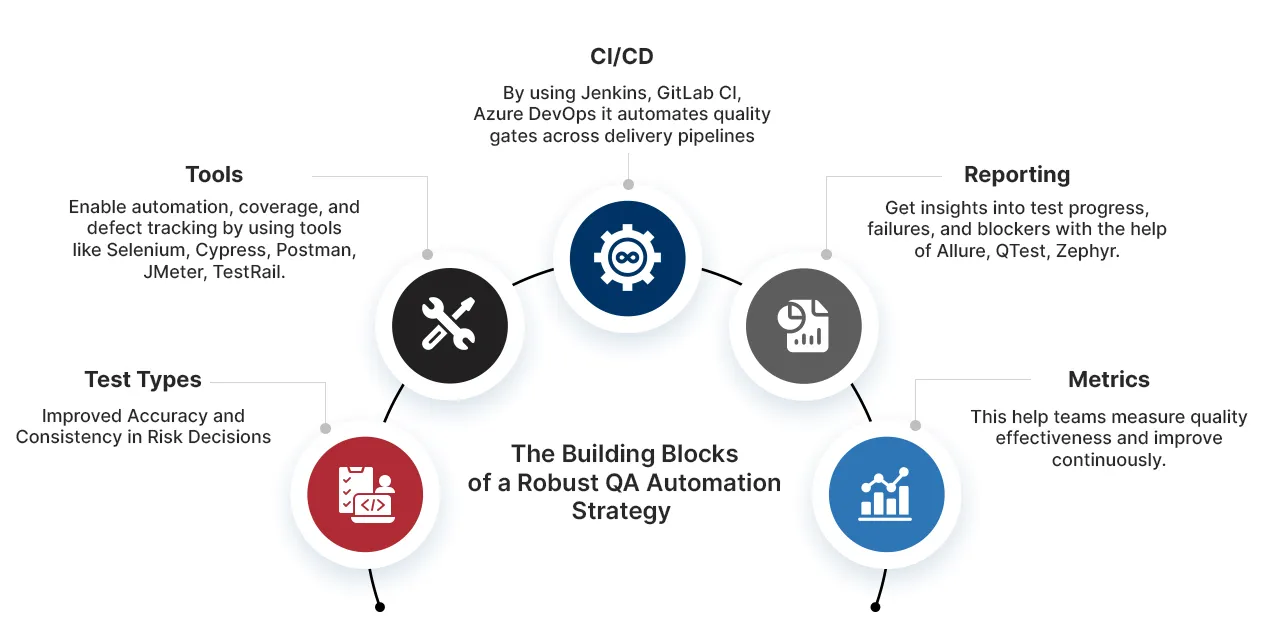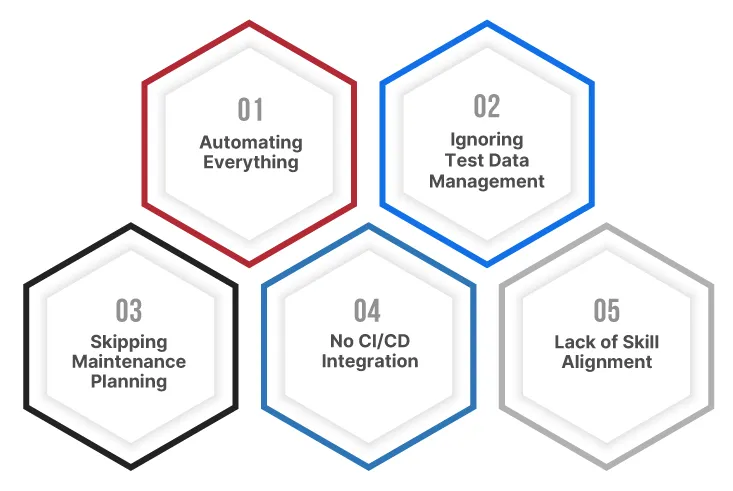Recommended Blogs

A Step-by-Step Guide to QA Automation Strategy
Table of Content
- What is QA Automation, and Why is it Essential?
- Top-5 QA Automation Tools
- How to Prioritize Test Cases for Automation
- How to build a QA Automation Framework?
- The Building Blocks of a Robust QA Automation Strategy
- How AI is Enhancing QA Automation
- Top 5 Mistakes in QA Automation Strategy
- QA Automation Challenges & Their Solutions
- Case Study: Insurance Transformation with AI‑Powered QA
- Benefits of QA Automation
- Conclusion
- Why Partner with TestingXperts for Automation QA?
Quality Assurance (QA) automation is now essential in the fast-paced business environment. It’s vital for software development teams wanting to be efficient and competitive. Nowadays, to keep up with quality standards while speeding up product creation, using QA automation methods is a necessity. The vast rise of the workflow automation market, forecasted to reach more than $34.4 billion by 2030, shows the value of automation.
The high manual testing costs and the growing complexity of software underline the importance of QA automation. The traditional way of QA testing is usually slow, prone to mistakes, and struggle to meet the quick launch dates the market requests. This lack of efficiency slows down work and can hurt a business’s profits. By sharpening the QA process, companies can become more efficient and cut costs linked to manual tests. Automation makes identifying and fixing errors faster, so top-quality products get to market sooner. This raises customer satisfaction and gives companies an advantage over their rivals.
What is QA Automation, and Why is it Essential?
QA Automation is an essential factor in today’s software development process. This method helps businesses run fixed set of tests on the software made. The main aim is to check if the software’s actions, dependability, and speed meet the set expectations.
Unlike checking software manually, QA Automation is all about letting tools take over the testing process. It minimizes people’s involvement and is great for repetitive tasks, plus tests that need a repeat, no matter the changes in conditions. The tests are made to work on different software types, settings, and gadgets. This method works really well in areas where tests need to be quick and regular.
The Necessity of QA Automation
Automated Quality Assurance is not just about rapid testing. It’s about making the development process efficient, accurate, and flexible. With software apps becoming intricate and demand for quick deployment rising, automated quality assurance ensures the quality and flexibility of software products. It’s a key element that goes beyond usual testing, assuring software works right and is high-performing and user-friendly.
• Automated quality assurance speeds up testing, saving time and reducing repetitive tests. This speed is important in Agile development, providing rapid feedback and speeding up the software development cycle.
• Automated tests repeat the same tasks, ensuring uniform results. This assured consistency is crucial in spotting flaws and mismatches that might be missed in manual testing due to human error. Manual testing becomes difficult as software projects become larger and more complex. Automated Quality Assurance adjusts without much effort with the software, allowing complete testing of intricate systems. It ensures total coverage, even as new features and changes are incorporated.
• Automation lets the software team tackle meaningful tasks by eliminating redundant tests. It helps the teamwork better by freeing up time for tasks that need human touch and ingenuity, like exploratory testing and enhancing user experience.
• Quality assurance automation is vital for consistently integrating and delivering models. It quickly and effectively verifies changes in code and ensures each integration is up to quality standards. Regular testing helps detect and resolve issues early, resulting in a more solid and dependable final product.
Top-5 QA Automation Tools
QA automation tools help teams automate repeat and tricky testing tasks more efficiently and correctly. They work for everything from websites to mobile platforms. Each tool can be adjusted to match the special needs of varied testing settings. Since these tools fit into development workflows and continuous testing, they are important in today’s software development practices.
Selenium
It offers a toolset for browser automation, works with many coding types like Java and Python and supports several browsers like Chrome, Safari, etc. Selenium WebDriver is a one-stop framework solution for creating sophisticated automation scripts.
Cypress
This QA tool is for contemporary web applications and works faster and more reliably by operating in-browser. Cypress features an exclusive test runner that provides command viewing during execution.
Appium
Appium is a free tool for mobile app testing automation. It caters to iOS and Android for cross-platform testing. Testing native apps with Appium doesn’t need an SDK or app recompilation, making it popular in mobile QA automation.
TestComplete
Developed by SmartBear Software, this tool automates UI testing for desktop, web, and mobile apps. It supports different scripting languages and has record and playback functions, appealing to both novices and experts.
Jenkins
This isn’t a testing tool. Still, Jenkins is a critical tool in QA automation because it enables continuous integration and delivery. It automates code deployment and testing, making project changes easier and preventing app breaks.
How to Prioritize Test Cases for Automation
Not all test cases are worth automating. Here’s a quick prioritization guide to help you focus on what drives the most ROI.
Priority |
Test Case Type |
Why Automate? |
| High | Repetitive regression tests | Run often, save time and reduce errors |
| High | Business-critical workflows | Directly impact user experience & revenue |
| Medium | Cross-browser or multi-device tests | Needed for wide coverage |
| Low | One-time or rarely executed tests | Not worth the automation effort |
| Low | Highly volatile UI tests | Expensive to maintain |
How to build a QA Automation Framework?
Developing a QA Automation Framework is a strategic process that involves careful planning and execution. It’s about creating a structured environment that allows automated testing to be more efficient, maintainable, and scalable.
Following are the steps involved in building a QA Automation Framework
Step-1 Define Objectives and Scope
First, get clear on what you want. Choose the tests for automation (maybe unit, integration, or UI tests) and set specific targets, like faster testing or better coverage. Also, decide the mix of platforms (web, mobile, desktop) and programming languages you need to support.
Step-2 Choose the Right Tools
The right tools make all the difference. Your choice should fit your tech, support your chosen tests, and come with good help resources. Selenium, Cypress, and Appium are tools suitable for QA automation tasks.
Step-3 Design the Framework Architecture
Your framework’s architecture shapes how you create test scripts. It could be modular, data-driven, keyword-driven, or hybrid. This stage is about organization, handling data, and preparing for different test scenarios.
Step-4 Develop Test Scripts
Now, create your test scripts according to your framework design. Aim for scripts that are reusable, easy to maintain, and scalable. Design a standard function library and templates for test cases, and ensure scripts are clear and straightforward.
Step-5 Implement Reporting and Logging
Setting up sturdy reports and logs is critical for monitoring test activities and results. It should offer clear details about test outcomes like pass/fail and point out any alarming areas or identified bugs.
Step-6 Integrate with CI/CD Pipeline
Connection to CI/CD pipelines is necessary for ongoing testing. It requires setting up the framework to auto-start tests when code changes or during select deployment pipeline points.
Step-7 Review and Update
Consistently check and adjust the framework to confirm it stays helpful and in sync with present best strategies. It involves renewing tools, fine-tuning scripts, and adapting to shifting software conditions.
The Building Blocks of a Robust QA Automation Strategy
To understand how modern quality practices are structured, it’s helpful to view them as interconnected layers. Each of them is supporting the next to ensure reliability and speed at scale:
Test Types:
Test includes Unit, Integration, Functional, Regression, UAT. It defines the scope and depth of validation.
Tools:
Enable automation, coverage, and defect tracking by using tools like Selenium, Cypress, Postman, JMeter, TestRail.
CI/CD:
By using Jenkins, GitLab CI, Azure DevOps it automates quality gates across delivery pipelines
Reporting:
Get insights into test progress, failures, and blockers with the help of Allure, QTest, Zephyr.
Metrics:
This help teams measure quality effectiveness and improve continuously.
How AI is Enhancing QA Automation
AI is reshaping test automation by tackling the most time-consuming pain points in QA. Here’s how:
-
Test Case Generation
AI analyzes user flows, requirements, or API specs to auto-generate relevant test cases. This reduces manual scripting effort and enhances test coverage.
-
Flaky Test Detection
AI identifies unstable test cases by monitoring patterns across test runs. This helps teams prioritize what to fix, ensuring more reliable pipelines.
-
Self-Healing Scripts
When UI elements change, AI can auto-update locators or selectors, preventing false failures and keeping tests stable without manual intervention
Top 5 Mistakes in QA Automation Strategy
-
Automating Everything
Not all test cases need automation. Focus on high-value, repeatable, and critical paths first. Use a risk-based prioritization matrix.
-
Ignoring Test Data Management
Poor test data can break even the best scripts. Use synthetic data or centralized test data pools to avoid flakiness.
-
Skipping Maintenance Planning
Test suites need upkeep. Set review cycles to remove obsolete scripts and adapt to UI or API changes.
-
No CI/CD Integration
Without pipeline integration, automation becomes a silo. Integrate tests into your DevOps flow for real-time feedback and faster deployments.
-
Lack of Skill Alignment
Choosing tools that don’t match your team’s skills leads to poor adoption. Pick tools that balance power and usability. This includes tools like Selenium, Cypress, or TestComplete.
QA Automation Challenges & Their Solutions
QA Automation in software development is vital but comes with challenges. These hurdles could harm the automation process if not correctly managed. Grasping and dealing with these issues is crucial for the automation framework to function at its best and achieve the expected results in software testing.

Setting Up Challenges
Setting up an automation framework can be tricky. It is important to pick useful tools and tailor them to the specific needs. The best way to do this is to research available tools. Look at things like how well they work with others, the support they offer and ease of use. Helping the team learn through training sessions and workshops can make this processes smoother.
Updating Test Scripts
As software progresses, test scripts can become old. Setting up a regular schedule to check over and renew test scripts is essential. This makes sure they match up with any new features or changes.
Merging with CI/CD
Mixing automated tests into CI/CD pipelines can have its issues. The key is making sure tests are reliable and quick for ongoing deployment. Pick automation tools that blend easily with CI/CD tools. Using best test management practices can streamline the process.
Dealing with Wrong Results
Sometimes, automated tests can give us wrong answers, leading us down the wrong path. Checking test cases regularly and using better validation methods can make these inaccurate results happen less.
Test Data Management
Managing and taking care of test data for different test situations can be a handful. Methods like data pooling, where test data is looked after centrally, and creating fake data, can make managing test data simple and faster.
Growth Problems
When the project enlarges, expanding the automation framework can be tricky. Creating the framework with the idea of growth from the get-go is vital. This involves using flexible design rules and making sure scripts and processes can be used again.
Case Study: Insurance Transformation with AI‑Powered QA
A leading U.S. InsurTech firm partnered with TestingXperts to overhaul its backend claims processing using RPA and deep learning. The transformation delivered:
- 40% improvement in operational efficiency
- 99% reduction in manual effort
- 40% QA cost savings
- 480 man‑hours saved
They automated claim report validation and enhanced accuracy, significantly reducing financial leakage.
Benefits of QA Automation
Incorporating automated testing into the software development process helps companies run smoother, be more precise, and quicker time-to-market. QA Automation plays a crucial role in software development by making the testing process faster and easier. Plus, it makes the software product much better in quality.
• Using automated testing shrinks the tons of time we’d usually need for extensive tests. How? Automated tests are speedy and can run concurrently. That means QA engineers can do more tests in less time! It is really helpful in repetitive and regression testing, where testers must do the same tests a bunch of times.
• Automated tests run the same steps every time, taking out the unpredictability and mistakes that can happen with manual tests. This steady approach guarantees that whether a test works or not, giving dependable and repeatable outcomes.
• Automated tools offer broader test coverage compared to human-done tests. These tools can handle lots of hard test cases each run, reaching levels that are hard with people-run tests. They can check for memory leaks, speed issues and more core features.
• Testers can run automated tests when new code comes in. If something goes wrong, the team will know right away. This leads to error or bug detection earlier in the development cycle. Early bug detections are cheaper and simpler to fix if found before the cycle’s end.
• Automated tests are a must-have for Agile and DevOps settings. As they rely on fast iterations and ongoing deployment, automation allows for speedy and constant feedback cycles. This makes sure each release is as error-free as it can be.
Conclusion
QA Automation holds a big role in modern software making. It helps the testing process be fast, reliable, and efficient. The gains from it, like better speed and precision, reduced expenses, and more extensive testing, can’t be denied. As firms handle the challenges that come with QA Automation, like problems in setup and operation, the suggested solutions provide a guide for smooth mix and enhancement. Using QA Automation, backed by a clear plan and the right tools, is not just a trend but a need in today’s software industry. It quickly allows team members to produce top-quality software products, leading to staying ahead and satisfying users in a fast-changing digital world.
Why Partner with TestingXperts for Automation QA?
Our QA professionals are deeply committed to excellence, leveraging the latest technologies and best practices in QA automation. We prioritize understanding your business needs, ensuring our approach aligns perfectly with your objectives. Our robust frameworks and methodologies are designed for scalability and efficiency, guaranteeing a streamlined process and high-quality results.
• Our in-house accelerator, Tx-Automate, enhances the efficiency and effectiveness of the testing process, enabling quicker deployment and higher-quality results. Tx-Automate streamlines the testing workflows, reduces manual efforts, and accelerates the overall testing cycle, providing clients with a cutting-edge solution that significantly boosts productivity and quality in software testing.
• Understanding the importance of budget, we provide cost-effective solutions without compromising quality. This approach ensures a high ROI, making your investment in QA automation smart and sustainable.
• Our experts utilize proven methodologies that have been refined over years of practice. This means clients benefit from reliable and efficient testing processes that have been tested in diverse scenarios.
• We employ the latest technologies and tools in QA automation, ensuring that clients receive state-of-the-art testing services. This commitment to technological advancement means your projects are always ahead of the curve.
• Recognizing the need for speed in today’s fast-paced business environment, we focus on delivering rapid results without compromising accuracy or thoroughness.
To know more, contact our QA automation testing experts now.
FAQs
QA Automation is an essential factor in today’s software development process. This method helps businesses run fixed set of tests on the software made. The main aim is to check if the software’s actions, dependability, and speed meet the set expectations.
A QA Automation Engineer should possess a strong mix of technical and analytical skills. Here’s a refined and more structured list of key skills:
Technical Skills:
1. Programming Languages: Proficiency in Java, Python, and SQL for writing automation scripts and database testing.
2. Framework Design & Development: Experience in creating and maintaining test automation frameworks (Selenium, TestNG, JUnit, Pytest, etc.).
3. QA Methodologies & Best Practices: Strong understanding of software testing principles (functional, regression, integration, performance testing).
4. Web Technologies: Familiarity with HTML, CSS, and JavaScript for UI automation. Automation Patterns: Knowledge of Page Object Model (POM),
5. Factory Pattern, and other design patterns for efficient test automation.
Discover more




